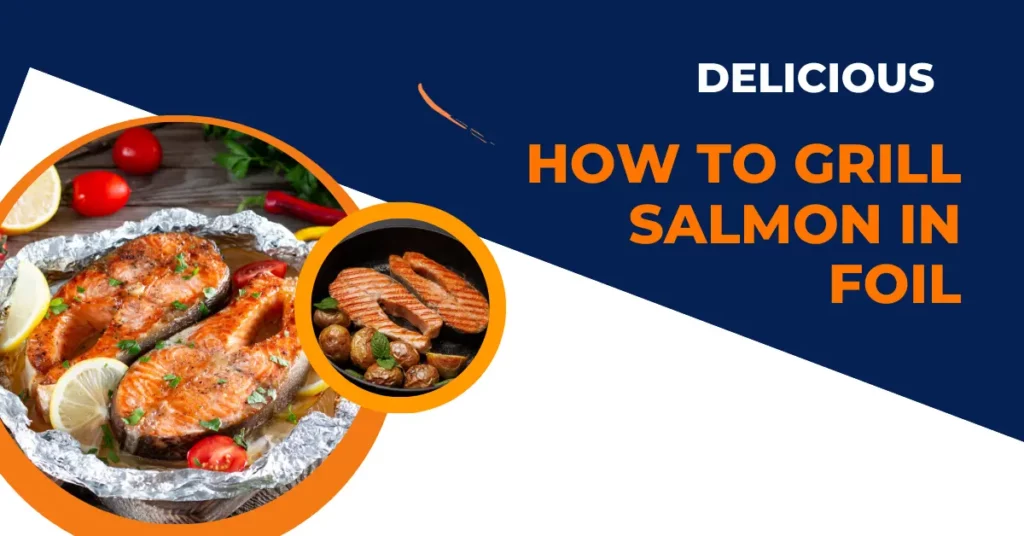This post may contain affiliate links. If you use these links to buy something we may earn a small commission. Thanks.
Grilling salmon in foil is one of the easiest and most effective ways to prepare this delicious fish. Whether you’re an experienced griller or just starting, foil-grilled salmon ensures a moist, flavorful dish with minimal cleanup. This method locks in juices, enhances the flavors, and makes serving a breeze. Let’s dive into the step-by-step guide to grilling salmon in foil, with tips and tricks to create a perfect meal every time.
Ingredients You’ll Need
The beauty of grilling salmon in foil lies in its simplicity. Here are the basic ingredients you’ll need:
Essential Ingredients
- Salmon Fillets: Fresh or frozen (thawed), skin-on or skinless. Opt for high-quality, wild-caught salmon if possible.
- Seasonings: A pinch of salt, freshly ground black pepper, and garlic powder are classics.
- Acid: Lemon slices or freshly squeezed lemon juice to brighten the flavor.
- Herbs: Fresh dill, parsley, or thyme add a delightful aroma and taste.
- Fat: Olive oil or a pat of butter to keep the salmon moist and prevent sticking.
Optional Additions
- Vegetables: Cherry tomatoes, asparagus spears, zucchini slices, or bell pepper strips make a complete meal in one packet.
- Sauces: Drizzle with teriyaki, honey mustard, or garlic butter for added richness.
Tools Required
- Aluminum Foil: Heavy-duty foil works best to prevent tearing and ensure even cooking.
- Grill: Gas, charcoal, or pellet grills all work well for this recipe.
- Tongs or Spatula: For safely handling the foil packets.
- Meat Thermometer: To check doneness without overcooking.

Preparation Steps
1. Preheat the Grill
Start by preheating your grill to medium-high heat, approximately 375°F to 400°F. Preheating ensures even cooking and prevents the salmon from sticking to the foil.
2. Prepare the Foil
Cut large sheets of aluminum foil, enough to completely wrap each salmon fillet with some room for air circulation. Lay the foil on a flat surface for easy assembly.
3. Season the Salmon
- Pat the salmon fillets dry with a paper towel to help the seasonings stick.
- Sprinkle salt, pepper, and garlic powder evenly over the fillets.
- Place thinly sliced lemon rounds on top of the salmon for a burst of citrus flavor.
- Add fresh herbs, such as dill or thyme, for a fragrant touch.
- Drizzle olive oil or place a small pat of butter on each fillet to enhance moisture and richness.
4. Add Vegetables (Optional)
If using vegetables, place them around the salmon on the foil. Lightly season the veggies with salt, pepper, and a drizzle of olive oil to ensure they cook evenly and absorb the flavors.
5. Seal the Foil Packets
Fold the foil over the salmon and crimp the edges tightly to create a sealed packet. Be sure to leave some space inside for air circulation, which helps steam the salmon and keeps it tender.
Grilling Instructions
1. Place Packets on the Grill
- Place the foil packets directly on the preheated grill grates.
- Position the salmon skin-side down if the skin is still attached.
2. Close the Grill Lid
Close the lid to trap the heat and cook the salmon evenly. This also helps infuse the fish with a subtle smoky flavor.
3. Cook the Salmon
- Grill the salmon for 10 to 15 minutes, depending on the thickness of the fillets. A general rule of thumb is to cook salmon for about 10 minutes per inch of thickness.
4. Check for Doneness
- Use a meat thermometer to ensure the internal temperature of the salmon reaches 145°F. This is the FDA-recommended temperature for safely cooked salmon.
- Alternatively, test the salmon by gently flaking it with a fork. If it flakes easily and is opaque throughout, it’s done.
Serving Your Grilled Salmon
1. Carefully Open the Packets
Use tongs or a spatula to transfer the foil packets to a plate. Be cautious when opening them, as hot steam will escape.
2. Transfer to a Plate
Gently slide the salmon and vegetables onto a serving plate. If the skin is attached, it should easily separate from the flesh when served.
3. Garnish and Enjoy
Add an extra squeeze of lemon juice, a sprinkle of fresh herbs, or a drizzle of your favorite sauce. Pair with a side dish like rice, quinoa, or crusty bread for a satisfying meal.
Tips and Variations
- Experiment with Flavors: Try different herbs and spices, such as smoked paprika, chili flakes, or rosemary, for a unique taste.
- Use Parchment Paper: If you prefer not to use aluminum foil, parchment paper can be an eco-friendly alternative for wrapping the salmon.
- Make it Spicy: Add a pinch of cayenne pepper or a drizzle of hot honey for a kick of heat.
- Add a Sauce: Brush the salmon with teriyaki, barbecue sauce, or a soy-ginger glaze before sealing the packets.
- Try Different Veggies: Swap out the vegetables for what’s in season or what you have on hand, such as green beans, mushrooms, or baby carrots.
Why Grilling Salmon in Foil is a Game-Changer
Grilling salmon in foil offers several advantages over traditional grilling methods:
- Locks in Moisture: The foil traps juices and flavors, ensuring tender and succulent salmon every time.
- Easy Cleanup: No messy grill grates to scrub—simply discard the foil after cooking.
- Customizable: You can adjust the seasonings, vegetables, and sauces to suit your preferences.
- Beginner-Friendly: Even if you’re new to grilling, this method is nearly foolproof.
Conclusion
Grilling salmon in foil is an effortless way to create a flavorful, healthy meal with minimal prep and cleanup. Whether you’re hosting a barbecue or preparing a quick weeknight dinner, this method delivers delicious results every time. With endless customization options and the convenience of foil packets, it’s no wonder this technique is a favorite among grilling enthusiasts. So grab some fresh salmon, fire up the grill, and enjoy the smoky, juicy perfection of foil-grilled salmon!
